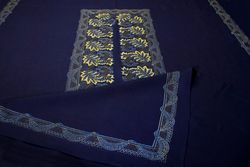Oľga Danglová
Eva Kováčová became a maker of dolls wearing folk costumes for the ÚĽUV in the 1950s. She started her full time career in the ÚĽUV in 1961. Later, she was promoted to an in-house visual artist of the ÚĽUV.
Designing the clothes for dolls, Eva Kováčová was carefully selecting a type of a folk costume which she then adequately reduced in size and form. She also believed it was important to preserve and emphasize typical regional aspects of folk costumes she made. She designed miniatures of original embroideries or printed patterns. She made imitations of original appliqués and metal accessories – filigree was replaced by coil wire, metal parts were replaced by tinfoil.
She made several collections of turned toys such as baby rattles, dolls, soldiers or animals in the early 1980s. Some of them were made to serve as jigsaw puzzles.
Cornhusk dolls designs are a separate part of the creative work of Eva Kováčová. The cornhusk figures which were marketed as “made in ÚĽUV” souvenirs were very popular in the 1960s and the 1970s. Eva Kováčová came with her own designs in the late 1960s. Later on, she made multi-figural fairy-tale compositions, four seasons’ compositions and sacral works. Her cornhusk nativity scenes which were very unique for that time were very popular shopping items.
In the 1980s, Eva Kováčová redirected her attention to blueprint in the contemporary interior design. She designed interior textiles such as table cloths, dining sets, duvets and pillowcases, curtains, some of them as single pieces, others as collections.
In the late 1980s, Eva Kováčová designed fashionable skirts and two-piece suits which were decorated with blueprint patterns. Besides, she designed coats made from cloth and raw wool cloth. She used men´s folk costume patterns for women blouses and combined them with laces, embroideries and hand-made strip linen. Eva Kováčová also designed slippers and felt boots (suing the archaic multi-strand weft technique). She got inspiration from the designs of Kamila Rauchová.
When she stopped working for the ÚĽUV in the early 1990s, Eva Kováčová has not lost contact with manual production. She has revived her rag doll designs.
Work of Eva Kováčová has been included in several exhibitions organised by the ÚĽUV. Her dolls wearing miniature folk costumes were repeatedly awarded at the renowned International biennial of regional dolls organised between 1974 – 2000 in Cepelia, Poland.
